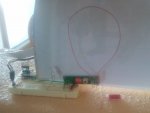bpowell: Any chance of a few pix to better illustrate this?
Although indeed often a "cut & try" technology, simple vertical antenna at UHF indeed can be little more than a piece of wire cut ¼ wavelength long. One wavelength at 315 MHz is 3x10^8/315x10^6 so such a ¼ wave whip will be ~230-240mm long (~9 inches). The only real benefit of a tight helix is that the design will be more compact- hardly an issue in your case. If you have swampy signal spots perhaps try elevating the antenna (so LOS obstacles are cleared) or using a low angle radiator type (such as a Slim JIM) -or even a directional Yagi. Slower data rates will usually improve performance too- even try 300 bps. Stan (ZL2APS)
Although indeed often a "cut & try" technology, simple vertical antenna at UHF indeed can be little more than a piece of wire cut ¼ wavelength long. One wavelength at 315 MHz is 3x10^8/315x10^6 so such a ¼ wave whip will be ~230-240mm long (~9 inches). The only real benefit of a tight helix is that the design will be more compact- hardly an issue in your case. If you have swampy signal spots perhaps try elevating the antenna (so LOS obstacles are cleared) or using a low angle radiator type (such as a Slim JIM) -or even a directional Yagi. Slower data rates will usually improve performance too- even try 300 bps. Stan (ZL2APS)



